Celebrating Black History Month
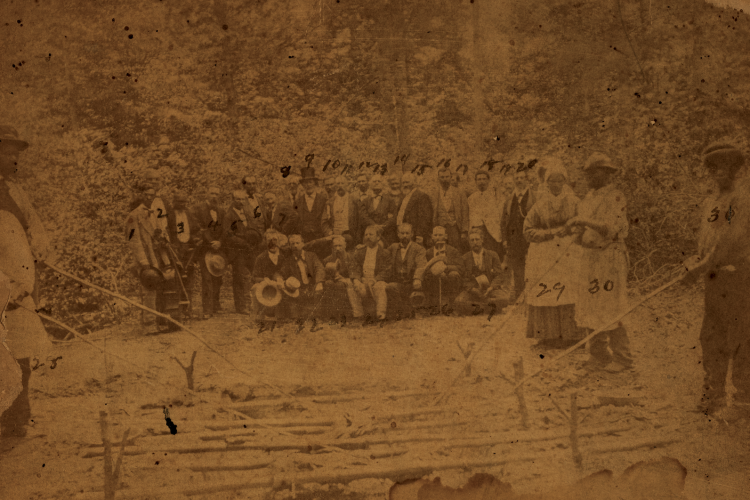
by David McCormick
When he with his violin, Graham Bell with his clarionet and Wambaw with the bass viol cut loose, there was only one thing to do, and that was — dance. When they struck up “Money Musk,” or “Wesson’s Slaughter House,” he was a chump indeed who could sit by and look on without clinching onto a pretty girl and joining the merry throng.
This quote from an 1887 article in the Chillicothe Leader describes the heyday of a band led by Eston Hemings, the once-enslaved son of Sally Hemings and Thomas Jefferson. Born in 1808, Eston bore a striking resemblance to his father. The author of a Daily Scioto Gazette article from 1902 recalls seeing a bronze statue of Jefferson in Washington, D.C., and thinking it looked especially like Eston. He described him as having a light-bronze skin tone, and standing just over six feet tall, with slightly auburn hair. He was dignified, polite, intelligent, and well-liked. Jefferson, of course, never acknowledged fathering children with Sally Hemings, but the resemblance caused a great deal of public and private speculation. Today, the DNA evidence is conclusive on the topic.
Beverly Hemings, Eston’s oldest brother, was born in 1798. According to Jefferson’s granddaughter Virginia Randolph, Beverly played for the dances arranged by her and her friends at Monticello:
On Saturday next the youngsters of Monticello intend to adjourn to the South-Pavilion and dance after Beverley’s music…Mama thinks we had better invite Mr. Stack as he is we hear, passionately fond of dancing.
In his published recollections, Isaac Jefferson, an enslaved blacksmith at Monticello, claims that Sally Hemings’s middle son Madison was also a fiddler, though Madison makes no such claim in his own recollections.
It’s no surprise that the Hemings boys were skillful fiddlers. Their father was an accomplished violinist who reportedly practiced several hours a day as a young man and was a voracious collector of fashionable European compositions—everything from Corelli sonatas to Scottish folk tune arrangements. Jefferson’s wife and daughters were also accomplished amateur keyboard and guitar players, and his brother Randolph was known to play his fiddle on Mulberry Row, home to Monticello’s enslaved residents.
Though Jefferson’s own Black children were clearly musically talented, he was predictably dismissive of Black musical talent:
In music they are more generally gifted than the whites with accurate ears for tune and time, and they have been found capable of imagining a small catch. Whether they will be equal to the composition of a more extensive run of melody, or of complicated harmony, is yet to be proved.
Though he begins with complimentary words, Jefferson is quick to downplay the ability to play by ear (no easy feat, actually), focusing instead on a purely European measure of musical talent, the composition of counterpoint. What must Jefferson have thought of the nine-year-old Afro-European violin virtuoso George Bridgetower upon hearing him play a fiendishly difficult Viotti concerto in Paris in May 1789, just four years after the above quote was published in Notes on the State of Virginia?
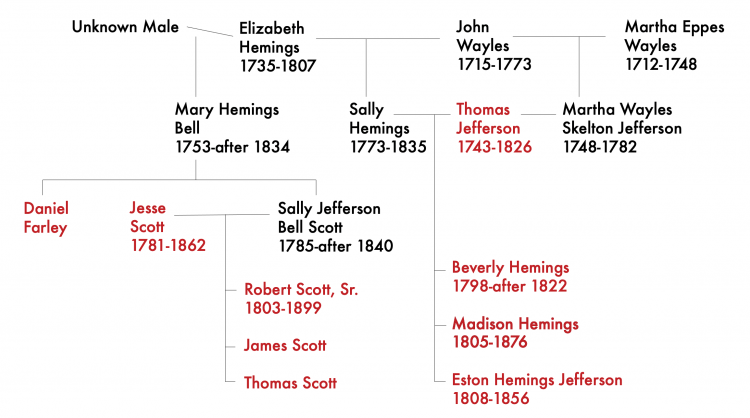
The number of fiddlers in the Hemings family tree extends well beyond Sally’s three sons (fiddlers are denoted in red in the illustration below). Hemings family matriarch Elizabeth Hemings was the enslaved concubine of Thomas Jefferson’s father-in-law, John Wayles. From that relationship came Sally Hemings, concubine of Thomas Jefferson. Elizabeth Hemings’s relationship with an unknown man resulted in the birth of Mary
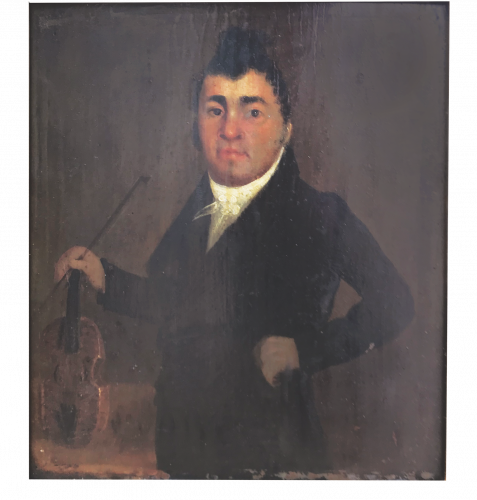
Hemings Bell, whose daughter Sally Jefferson Bell married Jesse Scott, head of a highly musical family. Jesse, his three sons, and an unknown number from the next two generations were all fiddlers. And then there’s fiddler Daniel Farley, who appears to have been the son of Mary Hemings Bell. Most, if not all, of these Hemings and Scott fiddlers lived on Main Street in downtown Charlottesville for a time, suggesting a vibrant musical culture housed on just a few city blocks.
Jesse Scott was the son of Anika Cumba, a Pamunkey Indian, and a white man, Governor Charles Scott of Kentucky. Because of his darker skin tone, Jesse was sometimes mistaken for a “mulatto,” as in the 1810 and 1811 Personal Property tax lists in Charlottesville. He seems to have inherited his love for music from his mother, who was a fine singer. He began playing the violin at a young age.
Jesse and Sally Jefferson Bell, grandchild of Elizabeth Hemings, had three sons, all of whom were taught to play various instruments by their parents, including violin and flute. Philena Carkin, a white teacher from Boston who taught free Blacks in Charlottesville, vividly describes their oldest son, Robert Scott, Sr., in her memoirs:
He had a very fair education, — picked up I cannot tell how, was well read and could converse ably upon all the important subjects of the day, whether it was the Reconstruction of the Confederate States, the Darwinian theory of the descent of man, or Woman Suffrage.
In her Southern Sketches of 1888, Orra Langhorne remarked on Robert’s relative wealth, noting the dark mahogany sideboard, fine China, cabinet organ, and sewing machine in the home, as well as a Franklin stove Jefferson once used at Monticello.
Middle son Thomas Scott accompanied William C. Rives and Edward Livingston, successive United States Ministers to France, as their valet. He apparently remained in France, married, and died there, losing touch with his American family —a very different choice than the one Sally Hemings had made decades before to return to Virginia after accompanying Jefferson in Paris.
Carkin describes youngest brother James Scott as “more reserved in his manner than his brother —perhaps not as well educated, and much less confident in conversation, but a very pleasant man to meet.”
From an 1874 article in the Charlottesville Chronicle, we learn that the three Scott brothers had a large number of children and grandchildren, “some of whom are being trained up in the way they should go, handling the bow with great facility, and giving assurance of a successful walk ‘in the way their fathers trod.’” Unfortunately, the only musician of record from those two generations is Robert Scott, Jr., who often played in the family band as violinist or cellist.
Robert Scott, Jr., known as “Buck” or “Buddy” to his friends, taught at the Jefferson School in Charlottesville, having been sent to Boston to finish his education. He directed school performances and was known to offer his services as musician for school functions, along with his father and uncle James.
As a baroque violinist, I’ve been fascinated by the idea of recreating the sounds of the Hemings and Scott bands from a performance-practice perspective. Perhaps the easiest place to start is with instrumentation. We know that the Eston Hemings Band, active from about 1837 to 1851, consisted of fiddle, clarinet, and “bass viol.” Eston’s clarinetist, Graham Bell, likely played a simple system clarinet, the five- to 12-key instrument we might associate with a Mozart orchestra. The “bass viol” here is likely a low-pitched, four-stringed instrument similar to a cello, built by American instrument makers starting in the late 18th century. It’s also worth mentioning the rumor that Thomas Jefferson gave his prized violin to Eston before dying.
More than 100 years after Eston set foot in Chillicothe, newspaper columnist E. S. Wenis wrote in the Chillicothe Gazette about the lasting legacy of the Eston Hemings band, tracing a lineage of so-called string bands with similar instrumentation: A Frenchman named Fougieries succeeded Hemings, followed by Black musician Uncle Jim West and then the Hunter boys, a family band well known throughout the region. This family band consisted of two fiddles, bass viol, clarinet, and cornet—an instrumentation that gets us a step closer to the early days of jazz.
Back in Virginia, the Scott family band usually consisted of three fiddle players, though Robert, Jr., sometimes played cello. The only extant portrait of Jesse Scott shows him holding a Tourte style bow. A photograph of Robert, Sr., Robert, Jr., and James is too fuzzy to offer much information, but it’s worth noting that throughout the 19th-century careers of these fiddlers, pure gut was the norm on the top three strings.
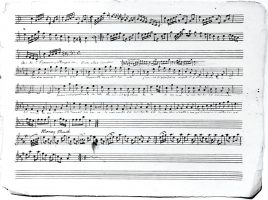
The Eston Hemings Band played for the dances and balls in Chillicothe, Circleville, Lancaster, Portsmouth, and Columbus, Ohio. From the quote that opens this article, we know they played “Money Musk” and “Wesson’s Slaughter House,” the former a well-known fiddle tune beloved by Thomas Jefferson and the latter a bit of a mystery. I’ve found no tunes by this name, though I wonder if it’s simply a variation on the Playford tune “Slaughterhouse.”
We can also infer some repertoire from what the Hunter Boys played just two decades later: the Virginia Reel and its European forerunner, “Roger of Coverly,” were very popular for generations; “Home, Sweet Home,” a tune found in the Monticello music collection more than once, was the last tune of the evening for the Hunter Boys. The waltz, varsobiana (a Polish dance with elements of the waltz, mazurka, and polka—“Put Your Little Foot” being the most popular American example), and redowa (a Czech variation on the waltz) were well-represented dance types in their repertoire. They charmed audiences with “My Pretty Red Rose,” the most popular song of the day. They would start playing at 8 p.m., take a break at midnight, and keep going until 4 a.m., playing about 24 dances!
The Monticello music collection is another source of potential repertoire, given the cross-pollination of musical knowledge that must have happened when Jefferson’s brother played on Mulberry Row. In addition to Jefferson’s handwritten copy of “Money Musk” and multiple versions of “Home, Sweet Home,” there are countless other dance tunes. One collection of tunes includes several dances from Carl Maria von Weber’s opera Der Freischütz and a tune called “LaFayette’s Quick Step.”
Might Jesse Scott have played the latter for the Marquis de Lafayette’s 1824 visit to Charlottesville, where Jesse was pegged to be the musical entertainment? The Scott family band played all over Virginia for college graduations, picnics, and balls, and reportedly entertained every sitting U.S. president for decades. Thomas Jefferson would stop by their Main Street home to listen to the family band play on his way to check on the construction of his University of Virginia.
Unlike Eston Hemings, the Scotts stayed in the South, leaving them to navigate racist environments like the mineral springs where elite rural plantation owners from all over the South would gather in the summers. They clearly managed a great deal of social mobility in spite of the odds, as we can see them standing side by side with former Confederate soldiers and other white elites in a photo from the Cool Springs Barbeque Club while Black servants are made to continue tending the barbeque pit as the photo is being taken.
The Scotts were musically literate, and Jesse reportedly composed quite a few reels. The name of one, “Birdwood Reel,” survives, but not the music.
Among the popular tunes of the day associated with the Scott family band were “Auld Lang Syne” and “Malbrouk se vat en guerre” (we know this tune as “He’s a Jolly Good Fellow”). They also played the most popular opera dances of the day, including tunes from Meyerbeer’s Robert le Diable and Auber’s La muette de Portici. Meyerbeer’s “Valse infernale” from the former, of course, became very popular outside the opera stage due to Franz Liszt’s virtuosic piano transcription.
So, we know the “who, what, when, where, and why” of the Hemings and Scott family musical careers, but what did this music sound like? I asked Seattle-based fiddler Benjamin Hunter to help me wrap my head around the style. The first thing Hunter wanted to emphasize is that “the idea of playing a bowed instrument wasn’t foreign to” people of African heritage. Various types of bowed fiddles could be found in Africa well before the slave trade began, he said, and these African roots are key to understanding the distinct sound of Black fiddling in America.
The repertoire of the Scott fiddlers provides a particular performance-practice challenge. While they clearly played the most popular reels of the day, they were also playing fashionable opera dances, many of which are quite sophisticated, even in their simplest forms.
Would the Scotts have played these tunes as if they were in a European opera pit? I first turn to my own experience for answers. Nowadays, having played baroque violin for many years, my modern violin playing has a lot more bow-sculpted shapes and much less vibrato. My body and brain have unlearned old habits and formed new (wonderful) ones.
Surely this same muscle memory applies to violinists who play mostly fiddle music but also classical tunes. I like to imagine that the Scotts couldn’t help but use the more compact bow stroke and ornamental slides of the fiddling tradition while playing Meyerbeer opera dances, and in my own experience, they sound absolutely fantastic this way.
Hunter counters that “it could have been just as classical sounding as anything else.” He offers the example of Lead Belly and the songster tradition. Lead Belly was equally at home in a variety of styles, including gospel, blues, and folk. And there are certainly violinists like Tessa Lark who inhabit the bluegrass and classical worlds equally well.
We know that the Scotts were musically literate, described as highly skilled musicians, carried themselves with great poise, were widely respected, and played for many posh events. Perhaps there was more refinement in their playing than we might think.
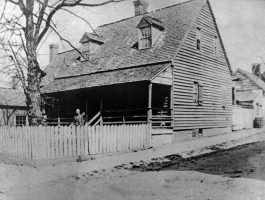
However, we can be sure their music wasn’t exactly understated and polite, according to Edward C. Mead in Historic Homes of the South-West Mountains Virginia (1898): “…and such music they made as the gods of Terpsichore will never hear again in this generation—such music as caused the old chateau to rock and reel to the cadence of the tripping feet and made old hearts young again.”
Hunter reminded me that “how you approach this music is going to come down to where you come from with this music.” Each new player in an aural tradition makes a tune their own. “The greatest players in the world…are the ones who break the rules a little bit…in the folk tradition that’s just how it is.”
As I began my own process of arranging the Hemings and Scott band tunes for performances using historical instrumentation, Hunter invited me to think of the way New Orleans trad jazz relies on a lot of call and response and interplay between the musicians and suggested this was one way to approach arranging folk tunes. It’s also important to remember that the fiddlers were the ones “calling the dances” as they were playing. Even if you don’t include the shouting out of dance steps in a concert performance (now I kind of want to!), the space one would need to leave for calling out the dance steps should inform arrangements.
Most importantly, these arrangements historically were spontaneous. Tunes would be repeated many times for the dancers, and there’s no doubt that instrumentation, ornamentation, and embellishment evolved on the spot. Perhaps the best modern approach to performing these tunes in concert is simply a few days of jam sessions with an experienced fiddler or two, culminating in a mostly spontaneous performance.
EDITOR’S NOTE: This article was commissioned in June, 2021 for EMAg, the Magazine of Early Music America. When violinist-scholar David McCormick submitted the article, we had no inkling that, four months later, he’d be appointed executive director of EMA.
 Baroque violinist David McCormick is the new Executive Director of Early Music America, Artistic Director of Early Music Access Project, and a founding member of medieval ensemble Alkemie. He was a 2020 Fellow of the Robert H. Smith International Center for Jefferson Studies and a 2017 recipient of Shenandoah Conservatory’s Rising Stars Alumni Award.
Baroque violinist David McCormick is the new Executive Director of Early Music America, Artistic Director of Early Music Access Project, and a founding member of medieval ensemble Alkemie. He was a 2020 Fellow of the Robert H. Smith International Center for Jefferson Studies and a 2017 recipient of Shenandoah Conservatory’s Rising Stars Alumni Award.
David McCormick’s Monticello research is the impetus behind several multimedia projects. Visit earlymusiccville.org to view a virtual walking tour profiling the lives of Monticello’s Black fiddlers in downtown Charlottesville (available March 2022). That same website will soon have information about screenings of the documentary film Black Fiddlers, based in part on McCormick’s research, and a March 6 concert in Charlottesville and online, Sacred Music of Monticello. A concert of folk music from Monticello will take place next season.


Pingback: Classical Music In Color – The Second Street Dreams Audio Network
Greetings,
What a phenomenal article!!! I am a direct descendant of
Mary Hemings (Great Great Great Great Great Great Grandmother)
-Sally Jefferson Bell (Great Great Great Great Great Grandmother)
-Robert Washington Bell Scott (Great Great Great Great Grandfather)
-Sally Bell Scott (Great Great Great Grandmother)
-Mary Thomas Sammons (Great Great Grandmother)
-Beatrice Evans (Great Grandmother)
-Leon Nathaniel Reaves (Grandfather)
-Merwyn Reaves (Father)
-ME (Robin Reaves Burke)
Please add me to your email list, I would love to learn more about screenings of the documentary film Black Fiddlers, based in part on McCormick’s research, and a March 6 concert in Charlottesville and online, Sacred Music of Monticello. A concert of folk music from Monticello will take place next season.